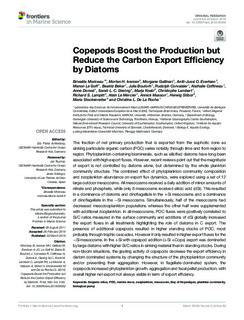| dc.contributor.author | Moriceau, Brivaela | |
| dc.contributor.author | Iversen, Morten H | |
| dc.contributor.author | Gallinari, Morgane | |
| dc.contributor.author | Evertsen, Jussi | |
| dc.contributor.author | Le Goff, Manon | |
| dc.contributor.author | Beker, Beatriz | |
| dc.contributor.author | Boutorh, Julia | |
| dc.contributor.author | Corvaisier, Rudolph | |
| dc.contributor.author | Coffineau, Nathalie | |
| dc.contributor.author | Donval, Anne | |
| dc.contributor.author | Giering, Sarah L.C. | |
| dc.contributor.author | Koski, Marja | |
| dc.contributor.author | Lambert, Christophe | |
| dc.contributor.author | Lampitt, Richard S. | |
| dc.contributor.author | Le Mercier, Alain | |
| dc.contributor.author | Masson, Annick | |
| dc.contributor.author | Stibor, Herwig | |
| dc.contributor.author | Stockenreiter, Maria | |
| dc.contributor.author | De La Rocha, Christina L. | |
| dc.date.accessioned | 2019-09-19T07:10:54Z | |
| dc.date.available | 2019-09-19T07:10:54Z | |
| dc.date.created | 2019-01-30T13:36:34Z | |
| dc.date.issued | 2018 | |
| dc.identifier.citation | Frontiers in Marine Science | nb_NO |
| dc.identifier.issn | 2296-7745 | |
| dc.identifier.uri | http://hdl.handle.net/11250/2617521 | |
| dc.description.abstract | The fraction of net primary production that is exported from the euphotic zone as sinking particulate organic carbon (POC) varies notably through time and from region to region. Phytoplankton containing biominerals, such as silicified diatoms have long been associated with high export fluxes. However, recent reviews point out that the magnitude of export is not controlled by diatoms alone, but determined by the whole plankton community structure. The combined effect of phytoplankton community composition and zooplankton abundance on export flux dynamics, were explored using a set of 12 large outdoor mesocosms. All mesocosms received a daily addition of minor amounts of nitrate and phosphate, while only 6 mesocosms received silicic acid (dSi). This resulted in a dominance of diatoms and dinoflagellate in the +Si mesocosms and a dominance of dinoflagellate in the −Si mesocosms. Simultaneously, half of the mesocosms had decreased mesozooplankton populations whereas the other half were supplemented with additional zooplankton. In all mesocosms, POC fluxes were positively correlated to Si/C ratios measured in the surface community and additions of dSi globally increased the export fluxes in all treatments highlighting the role of diatoms in C export. The presence of additional copepods resulted in higher standing stocks of POC, most probably through trophic cascades. However it only resulted in higher export fluxes for the −Si mesocosms. In the +Si with copepod addition (+Si +Cops) export was dominated by large diatoms with higher Si/C ratios in sinking material than in standing stocks. During non-bloom situations, the grazing activity of copepods decrease the export efficiency in diatom dominated systems by changing the structure of the phytoplankton community and/or preventing their aggregation. However, in flagellate-dominated system, the copepods increased phytoplankton growth, aggregation and fecal pellet production, with overall higher net export not always visible in term of export efficiency. | nb_NO |
| dc.language.iso | eng | nb_NO |
| dc.publisher | Frontiers Media | nb_NO |
| dc.rights | Navngivelse 4.0 Internasjonal | * |
| dc.rights.uri | http://creativecommons.org/licenses/by/4.0/deed.no | * |
| dc.title | Copepods boost the production but reduce the carbon export efficiency by diatoms | nb_NO |
| dc.type | Journal article | nb_NO |
| dc.type | Peer reviewed | nb_NO |
| dc.description.version | publishedVersion | nb_NO |
| dc.source.volume | 5 | nb_NO |
| dc.source.journal | Frontiers in Marine Science | nb_NO |
| dc.identifier.doi | 10.3389/fmars.2018.00082 | |
| dc.identifier.cristin | 1668852 | |
| dc.description.localcode | Copyright © 2018 Moriceau, Iversen, Gallinari, Evertsen, Le Goff, Beker, Boutorh, Corvaisier, Coffineau, Donval, Giering, Koski, Lambert, Lampitt, Le Mercier, Masson, Stibor, Stockenreiter and De La Rocha. This is an open-access article distributed under the terms of the Creative Commons Attribution License (CC BY). The use, distribution or reproduction in other forums is permitted, provided the original author(s) and the copyright owner are credited and that the original publication in this journal is cited, in accordance with accepted academic practice. No use, distribution or reproduction is permitted which does not comply with these terms. | nb_NO |
| cristin.unitcode | 194,66,10,0 | |
| cristin.unitname | Institutt for biologi | |
| cristin.ispublished | true | |
| cristin.fulltext | original | |
| cristin.qualitycode | 1 | |

